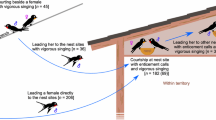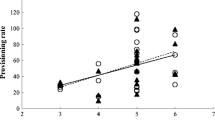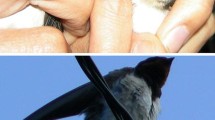Abstract
In diverse taxa, offspring solicit parental care using complex displays, which may evolve as reliable signals of condition or as mechanisms to manipulate parental investment. Differential sex allocation may therefore result from adaptive parental decisions or sex-related variation in competitive ability or because of sex-related asymmetries in kin selection. Under normal food provisioning, female barn swallow (Hirundo rustica) nestlings begged more loudly but did not receive more food than male nestlings. After food deprivation, begging call loudness of males but not females increased. Begging loudness positively predicted the number of feedings received by the nestlings, and males gained more mass than females after food deprivation. Male nestlings are more severely affected by chronic food reduction and may therefore accrue a larger benefit compared to females by increasing their food intake under short-term conditions of food scarcity. These results suggest that either females do not increase begging intensity to favour male broodmates which are more vulnerable to prolonged food stress, or that males prevail in scramble competition despite being similar in size to females.


Similar content being viewed by others
References
Aviles L, McCormack J, Cutter A, Bukowski T (2000) Precise, highly female-biased sex-ratios in a social spider. Proc R Soc Lond B Biol Sci 267:1445–1449
Bortolotti GR (1986) Influence of sibling competition on nestling sex ratios of sexually dimorphic birds. Am Nat 127:495–507
Brown WD, Keller L, Sundström L (2002) Sex allocation in mound-building ants: the roles of resources and queen replenishment. Ecology 83:1945–1952
Cameron EZ (2004) Facultative adjustment of mammalian sex ratio in support of the Trivers-Willard hypothesis: evidence for a mechanism. Proc R Soc Lond B Biol Sci 271:1723–1728
Charnov EL (1982) The theory of sex allocation. Princeton University Press, Princeton
Clutton-Brock TH (1991) The evolution of parental care. Princeton University Press, Princeton
Clutton-Brock TH, Albon SD, Guinness FE (1984) Maternal dominance, breeding success and birth sex-ratios in red deer. Nature 308:358–360
Clutton-Brock TH, Albon SD, Guinness FE (1985) Parental investment and sex differences in juvenile mortality in birds and mammals. Nature 313:131–133
de Ayala RM, Martinelli R, Saino N (2006) Vitamin E supplementation enhances growth and condition of nestling barn swallows (Hirundo rustica). Behav Ecol Sociobiol 60:619–630
Ellegren H, Gustafsson L, Sheldon BC (1996) Sex ratio adjustment in relation to paternal attractiveness in a wild bird population. Proc Natl Acad Sci USA 93:11723–11728
Ferrari RP, Martinelli R, Saino N (2006) Differential effects of egg albumen content on barn swallow nestlings in relation to hatch order. J Evol Biol 19:981–993
Fisher RA (1930) The genetical theory of natural selection. Clarendon Press, Oxford
Godfray HCJ (1991) Signalling of need by offspring to their parents. Nature 352:328–330
Godfray HCJ (1995a) Signalling of need between parents and young: parent–offspring conflict and sibling rivalry. Am Nat 146:1–24
Godfray HCJ (1995b) Evolutionary theory of parent-offspring conflict. Nature 376:133–138
Hamilton WD (1964) The genetical evolution of social behavior. J Theor Biol 7:1–52
Hardy ICW (2002) Sex ratios: concepts and research methods. Cambridge University Press, Cambridge
Kilner R (2002) The evolution of complex begging displays. In: Wright J, Leonard ML (eds) The evolution of begging. Kluwer, Dordrecht, pp 87–106
Kilner R, Johnstone RA (1997) Begging the question: are offspring solicitation behaviours signals of need? Trends Ecol Evol 12:11–15
Laaksonen T, Fargallo JA, Korpimäki E, Lyytinen S, Valkama J, Pöyri V (2004) Year- and sex-dependent effects of experimental brood sex ratio manipulation on fledging condition of Eurasian kestrels. J Anim Ecol 73:342–352
Lessells CM, Mateman AC, Visser J (1996) Great tit hatchlings sex ratios. J Avian Biol 27:135–142
Lorenzi MC, Sella G, Schleicherova D, Ramella L (2005) Outcrossing hermaphroditic polychaete worms adjust their sex allocation to social conditions. J Evol Biol 18:1341–1347
Macnair MR, Parker GA (1979) Models of parent-offspring conflict. III. Intra-brood conflict. Anim Behav 27:1202–1209
Magrath MJL, van Lieshout E, Visser GH, Komdeur J (2004) Nutritional bias as a new mode of adjusting sex allocation. Proc R Soc Lond B Biol Sci (Suppl) 271:S347–S349
Martins TLF (2004) Sex-specific growth rates in zebra finch nestlings: a possible mechanism for sex ratio adjustment. Behav Ecol 15:174–180
Mock DW, Parker GA (1997) The evolution of sibling rivalry. Oxford University Press, New York
Møller AP (1994) Sexual selection and the barn swallow. Oxford University Press, Oxford
Owen-Ashley NT, Hasselquist D, Wingfield JC (2004) Androgens and the immunocompetence handicap hypothesis: unraveling direct and indirect pathways of immunosuppression in song sparrows. Am Nat 164:490–505
Parker GA, Macnair MR (1979) Models of parent-offspring conflict. IV. Suppression: evolutionary retaliation by the parent. Anim Behav 27:1210–1235
Potti J, Merino S (1996) Parasites and the ontogeny of sexual size dimorphism in a passerine bird. Proc R Soc Lond B Biol Sci 263:9–12
Price K, Ydenberg R, Daust D (2002) State-dependent begging with asymmetries and costs: a genetic algorithm approach. In: Wright J, Leonard ML (eds) The evolution of begging. Kluwer, Dordrecht, pp 21–42
Saino N, Calza S, Møller AP (1997a) Immunocompetence of nestling barn swallows in relation to brood size and parental effort. J Anim Ecol 66:827–836
Saino N, Primmer CR, Ellegren H, Møller AP (1997b) An experimental study of paternity and tail ornamentation in the barn swallow (Hirundo rustica). Evolution 51:562–570
Saino N, Calza S, Ninni P, Møller AP (1999) Barn swallows trade survival against offspring condition and immunocompetence. J Anim Ecol 68:999–1009
Saino N, Ninni P, Incagli M, Calza S, Sacchi R, Møller AP (2000) Begging and parental care in relation to offspring need and condition in the barn swallow (Hirundo rustica). Am Nat 156:637–649
Saino N, Ambrosini R, Martinelli R, Calza S, Møller AP, Pilastro A (2002) Offspring sexual dimorphism and sex-allocation in relation to parental age and paternal ornamentation in the barn swallow. Mol Ecol 11:1533–1544
Saino N, Galeotti P, Sacchi R, Boncoraglio G, Martinelli R, Møller AP (2003) Sex differences in begging vocalizations of nestling barn swallows, Hirundo rustica. Anim Behav 66:1003–1010
Sheldon BC, Merilä J, Lindgren G, Ellegren H (1998) Gender and environmental sensitivity in nestling collared flycatchers. Ecology 79:1939–1948
Stearns SC (1992) The evolution of life-histories. Oxford University Press, Oxford
Tella JL, Scheuerlein A, Ricklefs RE (2002) Is cell-mediated immunity related to the evolution of life-history strategies in birds? Proc R Soc Lond B Biol Sci 269:1059–1066
Trivers RL (1974) Parent–offspring conflict. Am Zool 14:249–264
Trivers RL, Willard DE (1973) Natural selection of parental ability to vary the sex ratio of offspring. Science 179:90–92
Tschirren B, Fitze PS, Richner H (2003) Sexual dimorphism in susceptibility to parasites and cell-mediated immunity in great tit nestlings. J Anim Ecol 72:839–845
Uller T (2006) Sex-specific sibling interactions and offspring fitness in vertebrates: patterns and implications for maternal sex ratios. Biol Rev 81:207–217
Vedder O, Dekker AL, Visser GH, Dijkstra C (2005) Sex-specific energy requirements in nestlings of an extremely sexually size dimorphic bird, the European sparrowhawk (Accipiter nisus). Behav Ecol Sociobiol 58:429–436
West SA, Shuker DM, Sheldon BC (2005) Sex-ratio adjustment when relatives interact: a test of constraints on adaptation. Evolution 59:1211–1228
Wright J, Leonard ML (2002) The evolution of begging. Kluwer, Dordrecht
Author information
Authors and Affiliations
Corresponding author
Additional information
Communicated by R. Gibson.
Rights and permissions
About this article
Cite this article
Boncoraglio, G., Martinelli, R. & Saino, N. Sex-related asymmetry in competitive ability of sexually monomorphic barn swallow nestlings. Behav Ecol Sociobiol 62, 729–738 (2008). https://doi.org/10.1007/s00265-007-0498-8
Received:
Revised:
Accepted:
Published:
Issue Date:
DOI: https://doi.org/10.1007/s00265-007-0498-8




